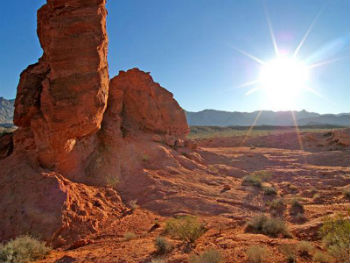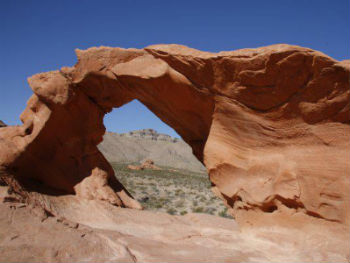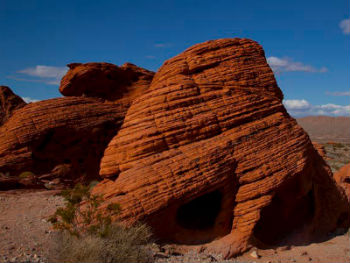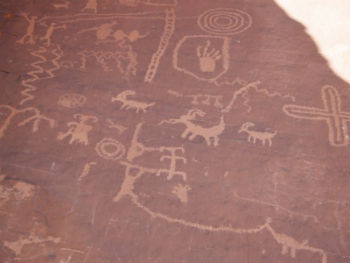Points of interest:
Petroglyphs,
Arch Rock,
Beehives,
Rainbow Vista,
Mouse's Tank,
Petroglyph Canyon,
Visitor Center

Valley of Fire
In a desert landscape ablaze with vibrant reds, oranges and yellows, unique forms rise from the sandy floor. Sun rays bathe the shapes in warm light as the sky’s color reflects the earth. As the entire scene knits together into a seamless sea of fiery color, you'll understand why it’s called the Valley of Fire.
Located 50 miles north of Las Vegas near Overton, Valley of Fire State Park remains one of Nevada’s hidden treasures. Its yearly attendance is around 300,000, which makes it less crowded than many parks and recreation areas closer to Las Vegas. However, Valley of Fire features just as many unique attractions for those who love to experience nature. The park provides ample opportunities for excellent photography as well as hiking and camping. The northern portion of Lake Mead is just outside the park, giving guests close access to water recreation too.
About
Established in 1935, Valley of Fire is Nevada’s oldest state park. The unique sandstone rock formations within the park were formed over 150 million years ago through fault shifting and extensive wind and water erosion. The iron oxide present within the sandstone gives the rock its reddish color. These rocks give the illusion of being “on fire” when reflecting the sun’s rays, especially during sunrise or sunset. Other notable rock at Valley of Fire include shales, limestones and conglomerates.
Despite sometimes extreme climate variations, Valley of Fire has been home to human inhabitants since 300 B.C. During the prehistoric era, the region was a hunting and gathering place for Native American tribes who inhabited the nearby Moapa Valley. Due to a scarcity of water, they didn’t settle in, but they did engrave images depicting their culture into the desert varnish. These engravings, called
petroglyphs, are quite popular at Valley of Fire. Many are in excellent condition and can be found throughout the park.

Arch Rock
|

Beehives
|

Petroglyphs at Valley of Fire
|
What to See
The centerpiece of Valley of Fire is the park’s many unique rock formations. Some of these brilliant forms so strongly resemble real-life objects that they have been named after them. Hence monikers like Elephant Rock, White Domes and Seven Sisters. All of these major attractions can be accessed via a convenient paved road system.
One of the most iconic formations in the park is
Arch Rock. As the name implies, the rock forms a massive archway that visitors can explore. Arch Rock is located off a scenic loop road that offers views of some of Valley of Fire’s most interesting formations, including Atlatl Rock, and Piano Rock. Located just south of the scenic loop, are the
Beehives. These unusual rock formations were created by the weathering forces of wind and rain.
Near the center of the park, guests can find
Rainbow Vista, which offers panoramic views of multicolor rock. This area, along with much of Valley of Fire, is popular for wedding and engagement photos. Just south of the vista is
Mouse’s Tank, which is named after a Paiute Indian fugitive who discovered this rock depression that stored rainwater for up to six months tucked away among the rock formations. Adjacent to Mouse’s Tank is
Petroglyph Canyon, where visitors can explore some of the more notable engravings by ancient peoples. This area, along with various other park sites, is home to a covered picnic area.
What to Do
Valley of Fire is also features a
visitor center that features a souvenir shop and exhibits explaining the unique history of the region. Guests interested in exploring one of Valley of Fire’s many hiking trails can talk with a park ranger at the center for recommendations before embarking on their journey.
Charles Loop is a flat, 6.7-mile hike that encounters several landmark rock formations and the Captain John G. Clark memorial along the former Arrowhead Highway, the original route connecting Salt Lake City to Los Angeles. In 1915, Clark stopped his buckboard wagon, tied up his horse and died where the memorial sits today. While hiking the cool narrows of the 5.5 mile White Dome trail, and other trails, you may encounter evidence of park wildlife such as bighorn sheep, coyotes, kit fox and the white tailed antelope ground squirrel.
Camping & Park Information
The Valley of Fire state park has 72 campsites divided between two campgrounds: the main Atlatl Rock campground (includes showers) and the more secluded Arch Rock campgrounds (no showers). Both campsites are equipped with shaded tables, grills, restrooms and water. Campsites are $20 per night, and RV sites are $30 per night. All sites are first come first serve.
The Valley of Fire state park is open year round, and the best time to visit is when the climate is not so hot in late fall, or even better in early spring when the wildflowers are in bloom. Remember, the desert climate features extreme weather patterns. Be sure to pack more than enough water, especially if you’re visiting during summer when temperatures can reach 100 degrees or higher.

